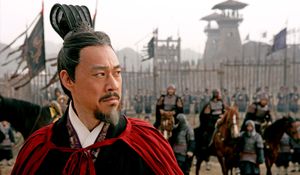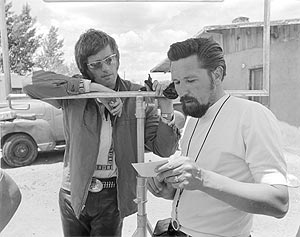
John Woo was asked to help the struggling Chinese film industry and he responded by returning to China to make his next film with Chinese cast and crew. The result is Red Cliff, opening in New York and select areas this weekend, a historical war epic shot and mounted on a grand scale. Set in 208 A.D. the film tells the story of the legendary Battle of the Red Cliffs, in which two relatively small kingdoms, south of the Yangzte River banded together to protect their homeland against the powerful warlord Cao Cao and his massive army, already in control of northern China.
The film is nothing if not an achievement. Struggling to make an American studio-sized epic with major infrastructure problems, the film suffered severe setbacks, including losing a stunt man during a fatal accident and having scheduled lead Chow Yun-Fat back out right before shooting (replaced by Tony Leung, a star of similar presence). Unfortunately, the film didn’t engage or enrapture me the way Woo’s best work can. The brutal battle sequences are never infused with the dramatic, emotional, psychological depth of his early Hong Kong work like Bullet in the Head, nor does it have the nutsy ridiculousness of his American films like Face/Off. And the history here is perhaps too ready-made for the movies as major narrative elements such as the underdog storyline, the brotherhood of inglorious bastards and the woman-as-spoil metaphor come off as little more than clichés. The film also seems rushed as it appears that a lot was cut, particularly from the story’s set up, a seemingly extended montage that could be Red Cliffs Notes. The film is allowed to breathe during battle sequences. And the lush photography and constantly moving camera could make almost any shot or sequence a perfect clip for a PBS cinema documentary. But as a whole the film is unfortunately light on power and majesty.

On the topic of those PBS documentaries, I hope you got to see this week’s Independent Lens. No Subtitles Necessary: Laszlo & Vilmos focused on the work of cinematographers Laszlo Kovacs and Vilmos Zsigmond as well as their lifelong personal relationship. The Hungarian cameramen escaped their home country during the Soviet invasion and armed with footage that caused a worldwide sensation. They would then break into American B-movies and eventually change the look of modern cinema with one or the other being director of photography on Easy Rider, Deliverance, Five Easy Pieces, Close Encounters of The Third Kind and dozens of other films that have been a part of your life if you’re a movie fan. I really admired the way the portrait of the filmmakers showcased some of their early work. Clips from cheapies like The Sadist and The Incredibly Strange Creatures Who Stopped Living and Became Mixed-Up Zombies come off like hallmarks of American cinema. I don’t know if I would call the documentary great or brilliant, but it was a lot of fun to stroll through the filmmakers’ work and understand their relationship. Not to mention half of Hollywood talking about how hot Laszlo Kovacs was. And simply seeing so many other major cinematographers on TV in such a short time was heaven for me as well.
–Pops Corn
